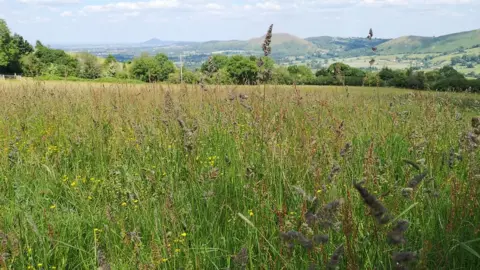Long Mynd: Rare bumblebee awards meadow nectar points
 David Williams
David WilliamsA meadow left to flower and re-grow has seen an increase of rare bumblebees.
The Bilberry Bumblebee is found in Jinlye meadow on the Long Mynd, Shropshire, which was taken over by the National Trust in 2014.
The meadow used to be grazed by sheep all year round, but is now managed as a hay meadow and only grazed on from winter until April, then left uncut through spring and summer.
A boost in nectar is said to be behind the bees' numbers.
The Bilberry Bumblebee is rare to the UK and needs high-altitude habitats such as heathland.
However, despite the bee in Long Mynd having the bilberry flower to feed on in the spring and heather in late summer, there is often a gap where it is looking for nectar.
But with Jinlye meadow now rich with flowers such as yellow rattle, it can "provide a nectar source to fill the hungry gap between the bilberry and the heather," said the National Trust's Andrew Perry.
Charlie Bell from the trust added the outcome "gives us hope".
"Seven years ago the meadow had very little value for wildlife, but this meadow is now full of different species," she said.
"It shows us that restoration can be done."
 NAtional Trust
NAtional TrustMs Bell said: "Over the past 200 years there is 97% less flower-rich hay meadows in the UK.
"This habitat was in danger of being lost altogether. It now doesn't just look nice but is providing homes and food for all types of species.
"This gives us hope for the future."

Follow BBC West Midlands on Facebook, Twitter and Instagram. Send your story ideas to: [email protected]
